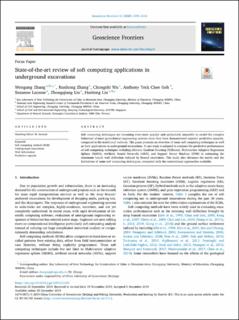State-of-the-art review of soft computing applications in underground excavations
| dc.contributor.author | Zhang, Wengang | |
| dc.contributor.author | Zhang, Runhong | |
| dc.contributor.author | Wu, Chongzhi | |
| dc.contributor.author | Goh, Anthony Teck Chee | |
| dc.contributor.author | Lacasse, Suzanne | |
| dc.contributor.author | Liu, Zhongqiang | |
| dc.contributor.author | Liu, Hanlong | |
| dc.date.accessioned | 2020-08-12T06:06:54Z | |
| dc.date.available | 2020-08-12T06:06:54Z | |
| dc.date.created | 2020-01-13T15:22:54Z | |
| dc.date.issued | 2019 | |
| dc.identifier.issn | 1674-9871 | |
| dc.identifier.uri | https://hdl.handle.net/11250/2671528 | |
| dc.description.abstract | Soft computing techniques are becoming even more popular and particularly amenable to model the complex behaviors of most geotechnical engineering systems since they have demonstrated superior predictive capacity, compared to the traditional methods. This paper presents an overview of some soft computing techniques as well as their applications in underground excavations. A case study is adopted to compare the predictive performances of soft computing techniques including eXtreme Gradient Boosting (XGBoost), Multivariate Adaptive Regression Splines (MARS), Artificial Neural Networks (ANN), and Support Vector Machine (SVM) in estimating the maximum lateral wall deflection induced by braced excavation. This study also discusses the merits and the limitations of some soft computing techniques, compared with the conventional approaches available. | |
| dc.language.iso | eng | |
| dc.title | State-of-the-art review of soft computing applications in underground excavations | |
| dc.type | Peer reviewed | |
| dc.type | Journal article | |
| dc.description.version | publishedVersion | |
| dc.source.journal | Geoscience Frontiers | |
| dc.identifier.doi | 10.1016/j.gsf.2019.12.003 | |
| dc.identifier.cristin | 1771704 | |
| cristin.ispublished | true | |
| cristin.fulltext | original | |
| cristin.qualitycode | 1 |
Tilhørende fil(er)
Denne innførselen finnes i følgende samling(er)
-
NGI articles [1061]
